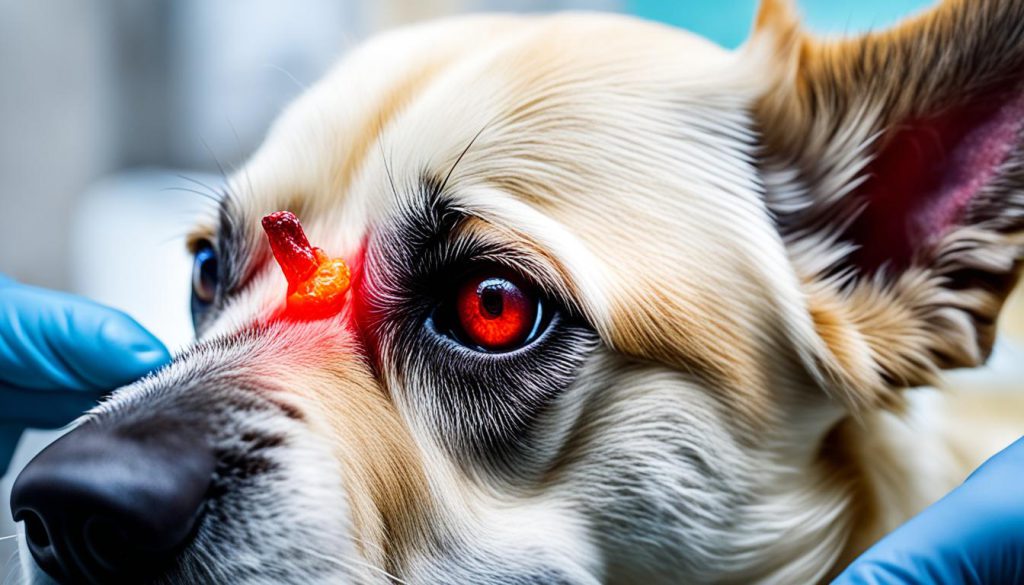Did you know some dog breeds have more health problems than others? It’s essential for dog owners to know about these issues. For instance, Bulldogs often have trouble breathing, while Dachshunds might hurt their backs.
Being aware is key to handling these health problems. Taking your dog for regular vet visits, feeding them right, and keeping them active can help stop many issues. Things like obesity and bad teeth can be avoided. If you’re interested in keeping your dog healthy, keep reading for more tips!
Key Takeaways
- Bulldogs are prone to breathing problems due to their physical characteristics.
- Regular vet check-ups and tailored care plans are vital for preventing prevalent health conditions.
- Obesity is a common issue in Labradors, necessitating a balanced diet and regular exercise.
- Pugs face significant risks of eye injuries, emphasizing the need for protective measures.
- Dental care is essential to prevent gum disease, one of the top health concerns in dogs.
Learn more about breed-specific health problems
Gum Disease in Dogs
Gum disease, also known as periodontal disease, is very common in dogs. If not treated, it can lead to serious issues. Knowing the causes, symptoms, and ways to prevent it is key for any pet owner.
Causes and Symptoms
Plaque and tartar buildup is the main cause of dental disease in dogs. This buildup harbors harmful bacteria that cause gum inflammation and infection. Genetics, age, diet, health, and oral hygiene also play a role in a dog’s dental health.
Signs of gum disease include:
- Bad breath (halitosis)
- Bleeding gums
- Pawing or rubbing at the mouth
- Drooling
- Decreased appetite or reluctance to eat
- Mouth odor
If gum disease gets worse, it can lead to severe pain. This may make a dog isolate themselves or act out. The disease can also affect the liver and heart, as bacteria from the mouth enter the bloodstream and reach the heart.
Prevention Tips
Preventing dental disease requires a comprehensive approach. A good dental care routine, including tooth brushing and pro cleanings, is crucial.
- Daily Brushing: Use toothpaste made for dogs with enzymes to fight plaque. Brushing every day is important because bacteria come back quickly.
- Professional Cleanings: Getting a pro dental check-up once a year can make a big difference in oral health.
- Owner Training: It’s important for pet owners to learn about dental care and how to do it right.
Dental chews, special dog food, and chew toys can also help keep your dog’s teeth clean. The Veterinary Oral Health Council (VOHC) approves dental products that meet high standards. Their approval means the product is good and supported by research.
We can keep common health problems like dental disease under control by being attentive and proactive. This ensures our pets live a long, happy life.
Ear Infections in Dogs
Ear infections are a big health issue for dogs, especially those with long ears. It’s vital to know what causes these infections and how to prevent them. This keeps our furry buddies happy and healthy.

Common Causes
Otitis externa is a common ear infection in dogs. It affects their outer ear. Dogs like Cocker Spaniels and Labradors get it a lot because their ears trap water easily. This water can cause bacteria and yeast to grow.
Things like swimming or the weather can add to this problem. Also, dogs with allergies or other health issues might get ear infections more often.
If your dog is scratching its ear a lot, shaking its head, or if there’s a bad smell, it could be an ear infection. You should see a vet. They can find out what’s wrong and treat it. Around 20% of dogs have ear diseases, so quick action is important.
Prevention Strategies
To prevent ear infections, clean your dog’s ears regularly. If your dog has health issues, manage them well. Also, make sure their ears are dry after they’ve been in water. Vets can suggest good ear cleaning products.
Check-ups are important too, ideally once a year. This can help catch any problems early. For dogs with a lot of ear hair, trimming it can help keep their ears dry.
Watch for signs that your dog is uncomfortable. Don’t try to fix ear infections at home. Always follow a vet’s advice. Going back for check-ups ensures the infection is gone. This helps your dog stay happy and healthy.
Common Health Issues
Dogs often face health challenges just like humans do. Different dog breeds have different common health problems. For example, Boxers are more likely to get cancer. This means they need regular check-ups at the vet and maybe even special treatments to prevent illness.
Dachshunds have a different issue; their long backs make them prone to back problems. It’s important to keep them at a healthy weight and limit activities that could hurt their spine. Proper exercise can help them stay healthy without putting too much strain on their backs.
Pugs often have problems with their eyes because they stick out more. They can get hurt easily or develop serious conditions like corneal ulcers. It’s vital to keep an eye on their health and get them to a vet fast if they show any eye problems.
Obesity is a big problem for all dog breeds. It can cause serious diseases like diabetes, heart issues, and arthritis. A balanced diet and regular exercise are key to keeping dogs healthy and avoiding obesity.
Knowing about and preventing common health issues is crucial for dog owners. Understanding breed-specific health risks and taking steps to prevent them can make a big difference in a dog’s life. It’s all about being proactive and caring for their health.
| Breed | Common Health Issues | Preventive Measures |
|---|---|---|
| Boxer | Cancer | Regular vet check-ups, preventive treatments |
| Dachshund | Back Problems | Weight management, appropriate exercise |
| Pug | Eye Emergencies | Eye health monitoring, prompt care |
Addressing common health challenges is key to having happy, healthy pets. It involves regular vet visits, exercise tailored to the dog’s needs, and preventive care. Doing these things helps our furry friends live longer, happier lives.
Obesity in Dogs
Obesity in dogs is a growing concern for many pet owners. More than half of North American dogs are overweight, says the Association for Pet Obesity Prevention. This not only lowers their quality of life but can also shorten it by up to two years.
Being overweight can cause many health problems in dogs. This includes diseases like cancer, diabetes, and heart disease. It can even lead to complications with anesthesia. Sometimes, obesity might point to other illnesses, such as hypothyroidism.
You can check if your dog is too heavy by feeling their ribs. If the ribs feel like your hand’s palm, your dog may be overweight.
Managing a dog’s weight successfully involves a few key steps. First, offer them a balanced diet that’s low in calories but still nutritious. Also, remember treats should be less than 10% of their daily food. Check out more tips on weight management.
It’s important to keep track of your dog’s weight every month. This helps adjust their diet and exercise as needed. Once the goal is reached, continue with the right diet and exercise to stop the weight from coming back. Consistent effort is crucial.
| Factors | Recommendations |
|---|---|
| Overweight Detection | Ribs feeling like the palm of your hand indicates obesity. |
| Diet | Lower calorie density, proper nutrient balance. Treats |
| Exercise | Regular, vigorous activity tailored to the dog’s capabilities. |
| Professional Guidance | Consult a vet for personalized diet and exercise plans. |
| Monitoring | Monthly weigh-ins to track progress. |
| Maintenance | Continued exercise and balanced diet to avoid regaining weight. |
Skin Allergies in Dogs
Understanding skin allergies in dogs is vital. These allergies can cause endless itching, sores, and infections. Knowing what triggers them is key to effective treatment and prevention.
Identifying Skin Allergies
Dogs might be allergic to grooming products, foods, or things in the environment. The most obvious sign is non-stop scratching. This may show as rashes or hot spots. Yeast infections can also bother their paws or ears, leading to more trouble.
Another issue is superficial bacterial folliculitis. It brings sores, bumps, and scabs, especially in dogs with short fur. Then, there’s seborrhea, which makes the skin greasy and flaky. It’s often a sign of other health problems.
Treatment and Prevention
To manage and prevent skin allergies, start with the diet. Omega-3 supplements and flea treatments help a lot. Also, use hypoallergenic shampoo to soothe itchy skin and avoid more problems.
Don’t forget about regular vet visits. Treat symptoms like excessive scratching or licking right away. These actions can greatly improve your dog’s life, keeping them happy and itch-free.
Hip Dysplasia in Large Breeds
Hip dysplasia affects many large breed dogs. It impacts their health and can lead to more joint issues. This condition is common in breeds like German Shepherds, Labrador Retrievers, and Great Danes. It happens due to their genes and fast growth.
Risk Factors
Several factors increase the risk of hip dysplasia in large breeds:
- Genetic predisposition: It’s a big factor. Dogs from affected breeds should get checked before breeding.
- Imbalanced growth rates: Rapid growth can cause uneven development of bones.
- Obesity: Extra weight puts more stress on the joints, making things worse.
- Poor diet: Not getting the right nutrients early on affects joint growth.
Preventative Measures
There are steps we can take to lessen the effects of hip dysplasia:
- Nutrition: Give large-breed puppies special food to avoid bone problems.
- Exercise: Right amount of exercise helps joints grow strong without extra stress.
- Weight management: Keep puppies at a healthy weight to lower their risk.
- Supplements: Things like glucosamine and chondroitin can help joint health.
- Responsible breeding: Test breeding dogs for hip dysplasia to avoid passing it down.
By following these steps, we can help our large breed dogs live better lives. They can stay happy and healthy, despite their genetic risks or joint issues.
Preventing Heartworm in Dogs
Heartworm disease is a serious threat to dogs, caused by mosquito bites. It’s common near the Atlantic and Gulf coasts and the Mississippi River. Yet, it can occur in all 50 states. Preventing heart disease in pets is very important.
Heartworms can live for 5 to 7 years. Male worms grow 4 to 6 inches long, while females can reach up to 12 inches. Dogs might have from 1 to 250 worms inside. This shows why yearly testing and prevention are key, especially where there are many mosquitoes.
Dogs can have different stages of heartworm disease, which worsen over time. Treatment exists for early stages but is expensive and risky. It requires lots of vet visits for tests and care.
Cats get heartworm less often and live with it for a shorter time, around 2 to 4 years. Even with fewer worms, it’s very dangerous for them because they are smaller. Treating cats is harder, making prevention vital.
The table below shows how heartworm disease affects dogs and cats differently:
| Heartworm Disease Attributes | Dogs | Cats |
|---|---|---|
| Typical Lifespan of Heartworms | 5 to 7 years | 2 to 4 years |
| Average Worm Burden | 15 worms | 1-2 worms |
| Percentage with Microfilariae in Bloodstream | 80-90% | 20% |
Heartworm disease can hit dogs, cats, and ferrets. Dogs with it can develop severe heart issues from having hundreds of worms. Yearly testing and preventing the disease with medicine are crucial. The American Heartworm Society highlights the need for annual tests and prevention to keep our pets safe and heartworm-free.
Understanding Canine Parvovirus
Canine parvovirus (CPV) mostly affects puppies aged six to 20 weeks. It can also hit older dogs. First seen in Europe in 1976, it quickly became a global issue by 1978. This virus causes severe illness in dogs’ stomachs and intestines.
What is Parvo?
Parvo shows up as tiredness, sadness, not wanting to eat, fever, throwing up, and diarrhea. These signs usually start three to seven days after the dog gets the virus. To diagnose it, vets use tests on the dog’s poop.
Treating parvo is a big deal. It involves giving fluids through a vein, nutrients, blood transfusions, antibiotics, and medicine to stop vomiting. Dogs that recover are immune to that parvo type for life.
Prevention Tactics
To prevent CPV, puppies should get shots starting at six weeks old until they are 16 weeks old. They also need more shots later. Keeping everything clean is also key because the virus can live a long time outside.
Staying clean and away from sick dogs or dirty places is important to stop the virus. Use bleach water to clean things that might have the virus on them. Some dogs, like Rottweilers, Doberman Pinschers, and English Springer Spaniels, are more at risk.
Getting our dogs vaccinated and keeping things clean can help protect them from parvovirus. This way, we can keep our furry friends safe.
Conclusion
It’s key to understand common health issues for the sake of pets and public health. Infectious diseases affect about 29% of people worldwide. Over eight million people die each year due to substance abuse. The rise in food prices, caused by the COVID-19 pandemic, conflicts, and climate disasters, has worsened malnutrition. This now impacts 29% of the global population.
Pollution and climate change are big threats to health, wildlife, and natural spaces. We must act by implementing preventive health measures. For dog owners, it’s about knowing specific health risks, keeping up with shots, and regular vet visits. Mental health issues are on the rise too, more common than cancer, which shows we need a full health strategy.
To improve our and our pets’ health, preventive measures are crucial. Owning a pet means taking steps to prevent health issues and enhancing wellbeing. Healthy eating and exercise are important for a long, happy life for our dogs. For more details on health challenges today, check out this informative resource.
Source Links
- https://www.webmd.com/pets/dogs/ss/slideshow-dog-breed-health-problems
- https://www.vet.cornell.edu/departments/riney-canine-health-center/canine-health-information/periodontal-disease
- https://www.guilfordjamestownvet.com/site/blog-greensboro-vet/2020/08/13/periodontal-disease-dogs-symptoms-causes-treatment
- https://www.aspcapetinsurance.com/resources/dog-ear-infections-causes-symptoms-and-prevention/
- https://www.akc.org/expert-advice/health/dog-ear-infections/
- https://vcahospitals.com/know-your-pet/ear-infections-in-dogs-otitis-externa
- https://www.urmc.rochester.edu/senior-health/common-issues/top-ten.aspx
- https://www.niehs.nih.gov/health/topics/conditions
- https://www.nm.org/healthbeat/healthy-tips/9-health-issues-every-woman-should-understand
- https://vcahospitals.com/know-your-pet/obesity-in-dogs
- https://www.webmd.com/pets/dogs/ss/slideshow-skin-problems-in-dogs
- https://www.blackmores.com.au/pet-health/skin-and-coat-health/5-most-common-skin-conditions-and-allergies-in-dogs
- https://www.akc.org/expert-advice/health/hip-dysplasia-in-dogs/
- https://www.angelpethospital.com/have-a-large-dog-what-to-know-about-hip-dysplasia
- https://vcahospitals.com/know-your-pet/hip-dysplasia-in-dogs
- https://www.fda.gov/animal-veterinary/animal-health-literacy/keep-worms-out-your-pets-heart-facts-about-heartworm-disease
- https://www.heartwormsociety.org/pet-owner-resources/heartworm-basics
- https://www.vet.cornell.edu/departments-centers-and-institutes/baker-institute/our-research/canine-parvovirus
- https://www.avma.org/resources-tools/pet-owners/petcare/canine-parvovirus
- https://snodgrassvet.com/understanding-canine-parvovirus/
- https://www.news-medical.net/news/20230503/What-are-the-top-10-public-health-challenges-in-2023.aspx

